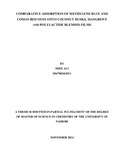| dc.contributor.author | Ali, Shee | |
| dc.date.accessioned | 2014-11-13T11:22:32Z | |
| dc.date.available | 2014-11-13T11:22:32Z | |
| dc.date.issued | 2014 | |
| dc.identifier.uri | http://hdl.handle.net/11295/74784 | |
| dc.description.abstract | The removal of two common recalcitrant textile dyes -cationic methylene blue (MB) and anionic congo red (CR)- from wastewaters was investigated in batch systems using coconut husks (CH), mangrove leaves (ML), mangrove bark (MBK), polylactide (PLA) and coconut husks-polylactide (CH-PLA) blended films. The adsorption efficacies of these adsorbents were compared with activated carbon (AC). Among the natural adsorbents studied CH was the best followed by MBK and finally ML.
Equilibrium adsorption capacities, qe (mg/g), for MB and CR dyes respectively were found to be 547.15±4.32mg/g and 13.22±0.19mg/g for AC, 55.12±0.02mg/g and 0.202±0.002mg/g for CH, 34.52±0.01mg/g and 0.179±0.004mg/g for MBK and 28.35±0.02mg/g and 0.162±0.014mg/g for ML respectively. Plain PLA had lower equilibrium adsorption capacity for MB dye at 1.92±0.06mg/g compared to 10.15±0.01mg/g for CH-PLA blended films.
Adsorption capacity increased with higher initial dye concentration, contact time and reducing adsorbent particle sizes. However it decreased with increased adsorbent dose. The adsorption process was influenced by both solution pH and ionic strength hence electrostatic. Optimum adsorption pH for MB and CR dye were 6.3-7.0 and 5.0 respectively. Higher ionic strength increased CR adsorption but decreased MB uptake. Temperature increase from 273K to 323K increased MB adsorption and decreased CR adsorption beyond 313K.
Equilibrium adsorption data for MB fitted the Langmuir isotherm model implying monolayer formation while CR obeyed the Freundlich isotherm model depicting multilayer formation onto the adsorbent. Adsorption kinetics for both dyes followed pseudo-second order model hence chemisorption was the main rate limiting step and intra-particle diffusion was solely not rate controlling. Therefore in addition to intra-particle diffusion, rate of dye removal from aqueous solution was greatly influenced by electrostatic interactions between dye molecules and adsorbent active sites.
This study has shown the viability of CH, ML, MBK, PLA and CH-PLA blended films for removal of MB and CR dyes in wastewaters. | en_US |
| dc.language.iso | en | en_US |
| dc.title | Comparative adsorption of methylene blue and Congo red dyes onto coconut husks, mangrove and polylactide blended films | en_US |
| dc.type | Thesis | en_US |
| dc.description.department | a
Department of Psychiatry, University of Nairobi, ; bDepartment of Mental Health, School of Medicine,
Moi University, Eldoret, Kenya | |
| dc.type.material | en_US | en_US |

